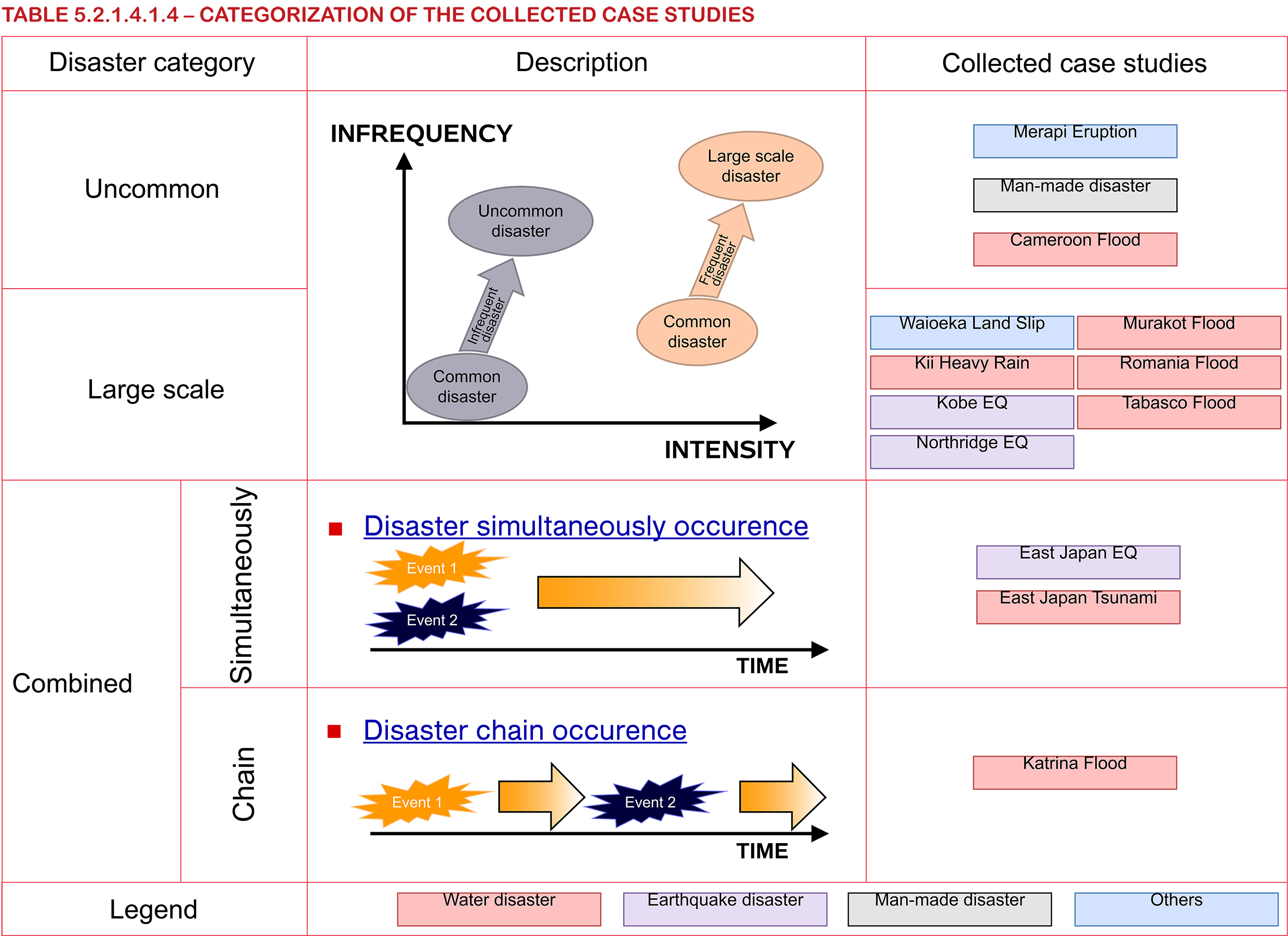
Disaster Management Manual
A manual for practitioners and decision makers!

Disaster Management Manual
A manual for practitioners and decision makers!
In order to analyze the weaknesses in disaster management that were realized from combined and large-scale disasters, an international survey was conducted to countries that suffered from major disasters. Table 5.2.1.4.1.1 provides the details of the international survey.
| Survey items | Description |
|---|---|
| Survey date | From May 2013 to May 2014 |
| Survey countries | Member countries of PIARC TC1.5 The countries that suffered from recent well-known major hazard |
| Survey form | Character of the disaster Major difficulty in disaster management ITS application in disaster management Review and lessons in terms of the key-words below Robustness Self-sustainedness Dynamic risk management |
Thirteen case studies were collected through the survey. Table 5.2.1.4.1.2 provides a list of these.
| Disaster | Reporter |
|---|---|---|
1 | [Large scale disaster –Large-] 1994 Northridge Earthquake, USA | Herby LISSADE Chief, Office of emergency Caltrans, USA |
2 | [Large scale disaster –Large-] 1995 Kobe Earthquake, Japan | Yukio ADACHI Chief maintenance engineer, Hanshin expressway, JAPAN |
3 | [Combined disaster -Simultaneous & Chain-] 2005 Hurricane Katrina, USA | James LAMBERT Professor University of Virginia, USA |
4 | [Large scale disaster –Large-] 2007 Tabasco flood, Mexico | Gustavo MORENO President, SESPEC MEXICO |
5 | [Combined disaster - Simultaneous -] 2009 Taiwan heavy rain, Taiwan | Chin-Fa, CHEN Directorate General of Highways MOTC, Taiwan |
6 | [Large scale disaster -Uncommon-] 2010 Eruption of Volcano Merapi, Indonesia | Djoko MURJANTO Director general of highways MOI, Indonesia |
7 | [Large scale disaster -Uncommon-] 2010 Chemical Spill, Hungary | Csilla KAMARAS Engineer National Transport Authority, Hungary |
8
| [Large scale disaster -Large-] 2010 Romania flood, Romania | Constantin ZBARNEA Regional Division of Roads and Bridges Iasi ROMANIA |
9 | [Combined disaster - Simultaneous -] 2011 East Japan earthquake, Japan | Yukio ADACHI Chief maintenance engineer, Hanshin expressway, JAPAN |
10 | [Large scale disaster –Large-] 2011 Kii Peninsula Heavy Rain, Japan | Yukio ADACHI Chief maintenance engineer, Hanshin expressway, JAPAN |
11
| [Large scale disaster -Uncommon-] 2012 Cameroon flood, Cameroon | Francis NDOUMBA MOUELLE Kizito NGOA Cameroon |
12 | [Large scale disaster -Large-] 2012 Waioeka Gorge Slip, New Zealand | Brett GLIDDON State Highway Manager New Zealand Transport Agency, New Zealand |
13 | [Large scale disaster -Large-] 2013 Queensland flood, Australia | Andrew EXCELL Regional Manager MeTRO, DPTI, Australia |
The collected experiences were categorized into uncommon disaster, large-scale disaster, simultaneously occurring disaster, and chain reaction disasters based on their mode, frequency of occurrence, scale, and status (see Table 5.2.1.4.1.3).
| Main characteristics | Disaster mode | Ocurrence | Scale of single disaster | Disaster status | ||
|---|---|---|---|---|---|---|
Large scale disasters | Uncommon | Single | Very rare | Medium | Does not change | |
Large scale | Rare | Large | ||||
Combined disasters | Simultaneously ocurring | Multiple | Simultaneous | Simultaneous | Does not change | |
Chain-reaction | Multiple | Consecutive | Consecutive | Changes with time | ||
Table 5.2.1.4.1.4 provides a description for the aforementioned categorizations and the collected case studies for each.
